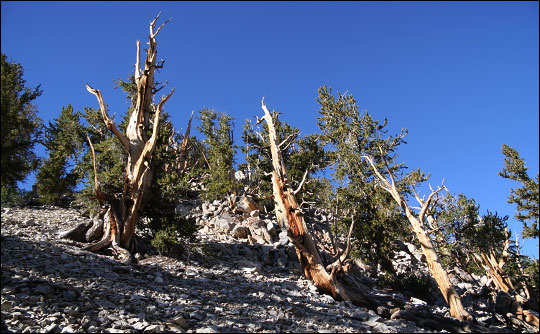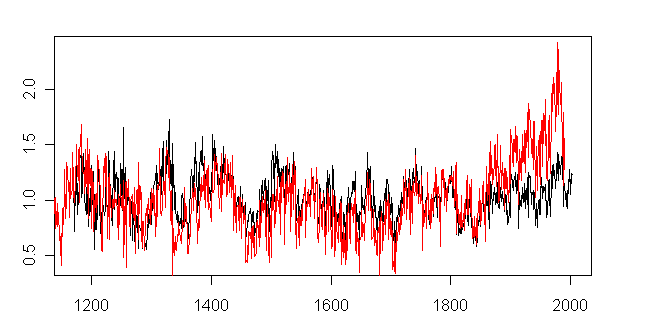
http://earthobservatory.nasa.gov/Study/Paleoclimatology_CloseUp/Images/bristlecones_methuselah.jpg
| Are bristlecones good proxies for past climate? |  http://earthobservatory.nasa.gov/Study/Paleoclimatology_CloseUp/Images/bristlecones_methuselah.jpg |
Here is a collection of comments and discussions on this important subject. Please remember that the hockeystick team (MBH98) and the IPCC relied heavily on tree rings from old bristlecones to conclude that the 20th century warming is unprecedented in the last 1000 years.
last edit: 03 Feb 2008
| from the New York Times blog
of Andrew Revkin
646.
|
1. There is a new (2006) study, a doctoral dissertation, by
Linah Ababneh of the University of Arizona that created a new bristlecone
tree ring series at Sheep Mountain California. This series is important
for three reasons. It reproduces much of the proxy series that was created
by D. Graybill and S. Idso at the same location. And the Graybill series
was heavily used by Mann and other members of the hockey team. It was
Mannís most heavily weighted series for MBH98 (390 times as heavily as
the lightest weighted series), and it continued to be used by Mann, Jones,
Crowley, Lowery, Osborn, Briffa, Hagerl, Rutherford, Wahl, Ammann, and the
IPCC. In fact, it is this series that gives Mannís reconstruction its
particular hockey stick shape. Mannís reconstruction does not differ
significantly from the series. The Ababneh series, like the Graybill
series, makes the MWP and the LIA disappear. But unlike the Graybill
series, it also makes the majority of 19th and 20th century warming
disappear. In those two centuries it diverges radically from the Graybill
series. Linah Ababneh and the University of Arizona have not released the
raw data for this study. It is important that they do, and Sen. Imhofe may
be able to help get that transparency.
2. The bristlecone series produced by Graybill and Idso from the Almagre Colorado site contained 41 tagged trees. But only 16 of these were ever archived. It is known that at least some of the trees that were tagged but not archived had core samples removed from them. Graybillís study involved proving the effect of CO2 on bristlecone growth. Is it possible that Graybill cherry picked his samples to get his hockey stick results - and that subsequently Mann and others used these cherry picked series as the backbone of their temperature reconstructions? Additionally, Steve McIntyre visited the same Almagre site and took a small sample of cores (8) from the Graybill trees. These showed no 19th and 20th century trends. I think that Sen. Imhofe needs an answer about the radical divergence of the Ababneh and Graybill series in the 19th and 20th centuries. 3. I also believe that Sen. Imhofe needs to commission an independent study of the Mann bristlecones, possibly reproducing the collection of samples at all of the sites. It is, after all, the Mann reconstructions, as well as all of the other reconstructions that are based upon Graybill data, that allow for the supposed consensus that the warming of the 20th Century is unprecedented in the last 1000 years. 4. The value of bristlecones as temperature proxies may in fact be completely worthless. These trees grow at high altitudes in very dry conditions - around 12 inches of precipitation per year. They are much more moisture limited than they are temperature limited. In fact, cooler years when the snow cover has a slow melting period, thereby supplying a steadier and longer flow of moisture to the trees, may actually be better for the trees. So it is possible, that at least part of the time, the bristlecone tree rings can be negatively correlated to temperature. Until the disparity between Ababneh, and McIntyre on the one hand, and Graybill on the other, can be resolved, the bristlecone series should be thrown out. This will take Mannís temperature reconstruction from being just somewhat flawed to being a complete waste of effort. The temperature reconstructions that we should count on today are the one done by Moberg et al. and the one done by Loehle and McCulloch(2008). And both of these state in their abstract that there is nothing extraordinary about 20th Century climate. If I were a journalist like Mr. Revkin I would not miss the opportunity to track this story down. ó Posted by Tilo Reber
|
| from Steve Mc.Intyre's blog ClimateAudit | 
Linah Ababneh and Graybill temperature anomaly graphs (z-scores). Read also here and here for the original Ababneh dissertation. |
Francis Massen
http://meteo.lcd.lu
2008
4:04 pm